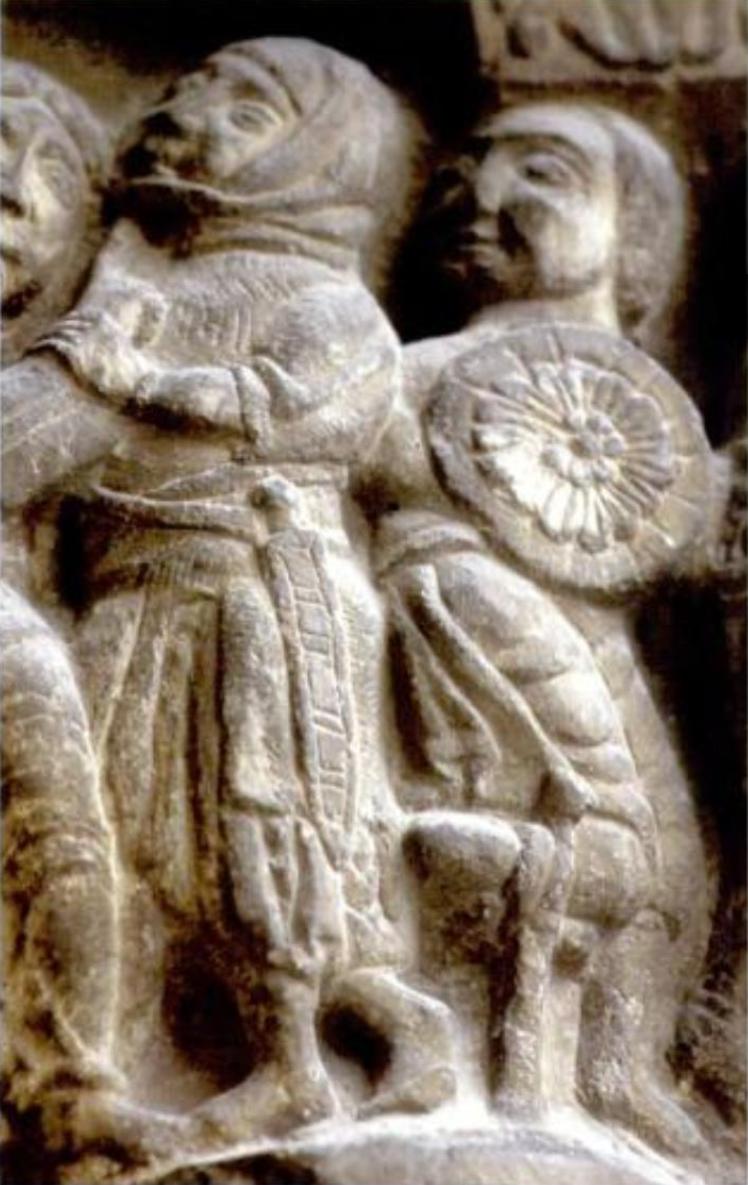The Arrest of Saint Aventinus St Aventin Church, France, 12th century  |
The Arrest of Saint Aventinus St Aventin Church, France, 12th century  |
The story of the martyrdom of St Aventinus and his colleague St Gratien later became popular across medieval France. They and their fellow pilgrims are said to have been caught by ‘Saracens’, probably from the Muslim advance guard or vanguard which had crossed the river Creuse at Port-de-Piles, and were killed at Civray-sur-Esves. Here the story is told on a 12th-century carving on the church at Saint-Aventin, in the foothills of the Pyrenees. For reasons that are unknown, one of the Saracens is shown as a cripple - a motif found elsewhere in southern France and northern Italy. (Authors photograph)
p.84, Poitiers AD 732: Charles Martel Turns the Islamic Tide by David Nicolle
Referenced on p.3, The Moors - The Islamic West - 7th-15th Centuries AD by David Nicolle
The Arrest of St Aventinus, in a late 12th-century carving on the door of the parish church in the French Pyrenean village of St Aventin. According to local legend, Aventinus was martyred by invading Moors in AD 732. Since the Islamic frontier was still only a short distance away on the far side of the mountains this representation of Andalusian Moorish warriors is probably more accurate than most. The central figure has a head cloth or litham, wears some form of semi-stiff armour perhaps of felt, and carries a short sword without quillons. The presence of a man with a round shield, a withered foot and a wooden leg is unexplained; intriguingly, he features in other illustrations from this part of southern France, including mosaics in Lescar Cathedral.
Referenced as figure 591 in The military technology of classical Islam by D Nicolle
591. Relief, Arrest of St. Aventin by Moors, late 12th century AD, south French, in Church of St. Aventin, Haute Garonne.
---
Vol. 1 p.40: Whether the heavy European falchion, perhaps first seen in 11th century southern France (Fig. 563 ), was an independent development or reflected a merging of these two traditions from north and south, remains unclear. There is, however, little doubt that comparable single-edged swords of various lengths continued to be used throughout most of the Muslim world in the 12th and 13th centuries (Figs. 177E-F, 178A-B, 250, 294, 401, 591, 609I and 641).
---
Vol 1 pp.169-170 Protective felt and leather garments were used in China, Iran and Byzantium in the immediate pre-Islamic era14 (Figs. 18, 43, 45, 46, 95, 102, 197 and 473). They continued to be worn in later centuries, particularly in Muslim Kurāsān15 and the rest of eastern Islam (Figs. 127, 198, 209, 341, 410, 609I, 625 and 642C). The well-documented popularity of felt and leather in the Muslim and Christian regions of the Iberian peninsula16
14. Laufur, op. cit., p. 292; Haldan, "Some Aspects of Byzantine Military Technology from the 6th to the 10th centuries," pp. 19 and 22; Aussareases, op. cit., p. 57; Fahmy, op. cit., pp. 149-150.
15. Al Jāḥiẓ, Rasāil al Jāḥiẓ, pp. 20-21.
16. Lévi-Provencal, Histoire de l’Espagne Musulmane, vol.III, pp.90-112; Anon., The Song of Roland, verse 247; Gabrieli, "Gli Arabi in Spagna e in Italia," pp. 709-711.
is likely to reflect Muslim influence from the Middle East or even beyond (Figs. 495, 497, 506, 511, 517, 521, 529 and 591). Armours of leather or felt are also recorded among non-Spanish European warriors during the 11th and 12th centuries,17 These may, however, refer either to men of the Languedoc or those influenced by southern French military styles which were themselves closely related to those of Christian Spain (Fig. 575).
17. Bahā al Dīn, op. cit., p. 251; Blair, op. cit., pp, 23-24.
Referenced on p.118, Arms and Armour of the Crusading Era, 1050-1350, Western Europe and the Crusader States by David Nicolle
299A-B ‘Arrest of St Aventin’, carved relief, Duchy of Gascony, late 12th century
(in situ south door of church, St Aventin, France)
This relief carving illustrating the life of St Aventinus includes some remarkable and probably accurate representations of the Muslims of al-Andalus. It was such ‘Moors’ who originally arrested the Bishop. The artist clearly drew upon his own or local knowledge of those Muslims who ruled territory about 300 kilometres away. The warriors have appropriately baggy trousers and in one case a head cloth recalling the lithām or ‘veil’ still worn by troops of Berber Saharan origin in the Iberian Peninsula. One has a small round shield (B), the other a single-edged sword without quillons (A). This latter feature was commonly associated with North African weapons. Both men also appear to wear a relatively stiff garment over their loose trousers. This falls down the front of one man’s hips (B) but is divided down the front on the other warrior (A). Perhaps it represents a form of soft or semi-rigid leather or felt protection such as might be seen in Spanish Mozarab manuscripts.